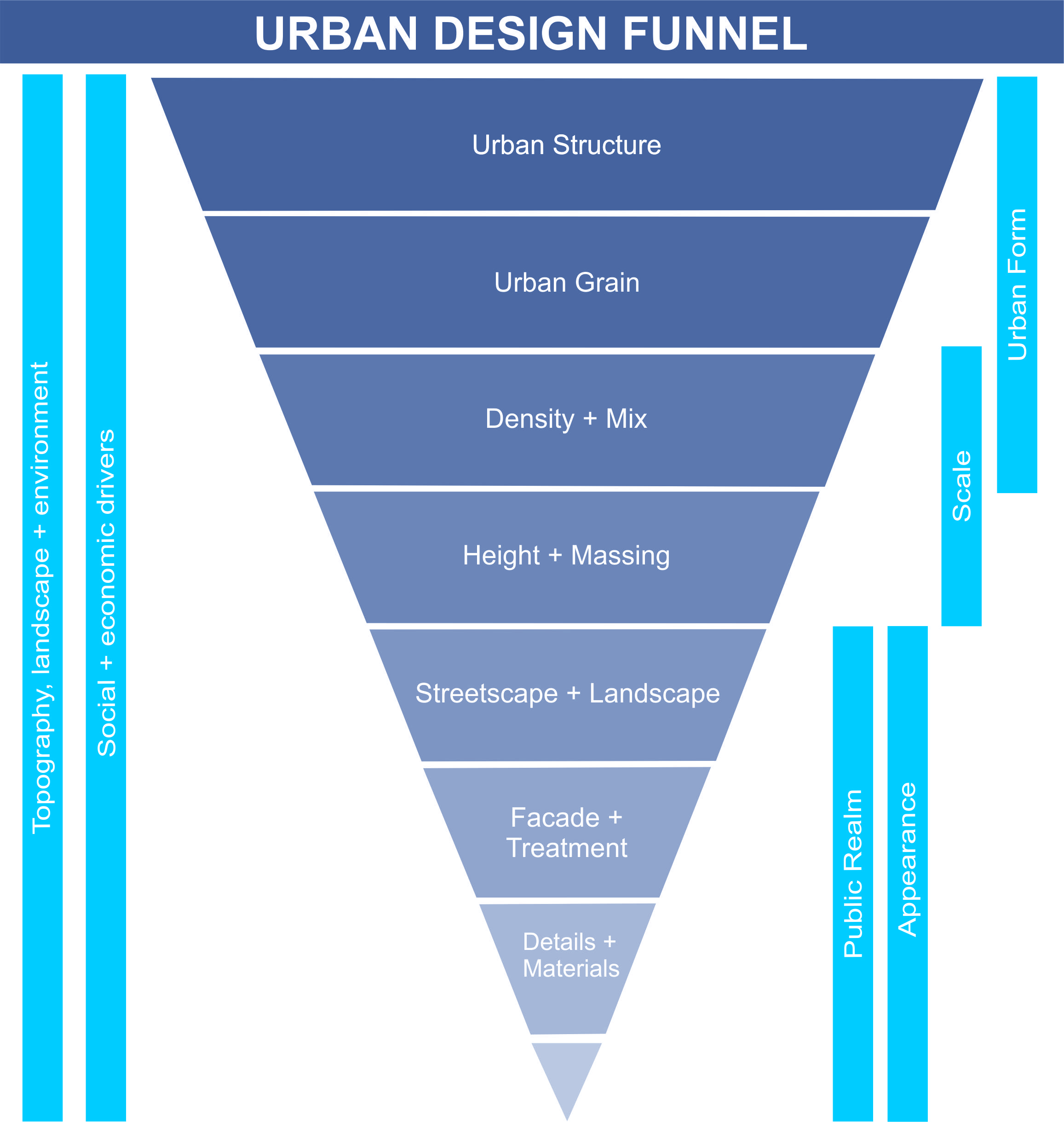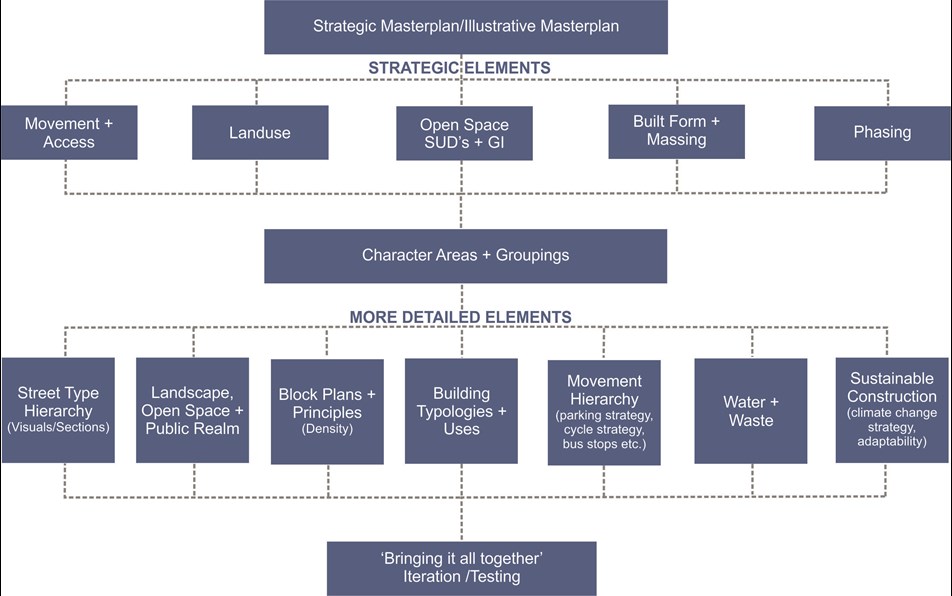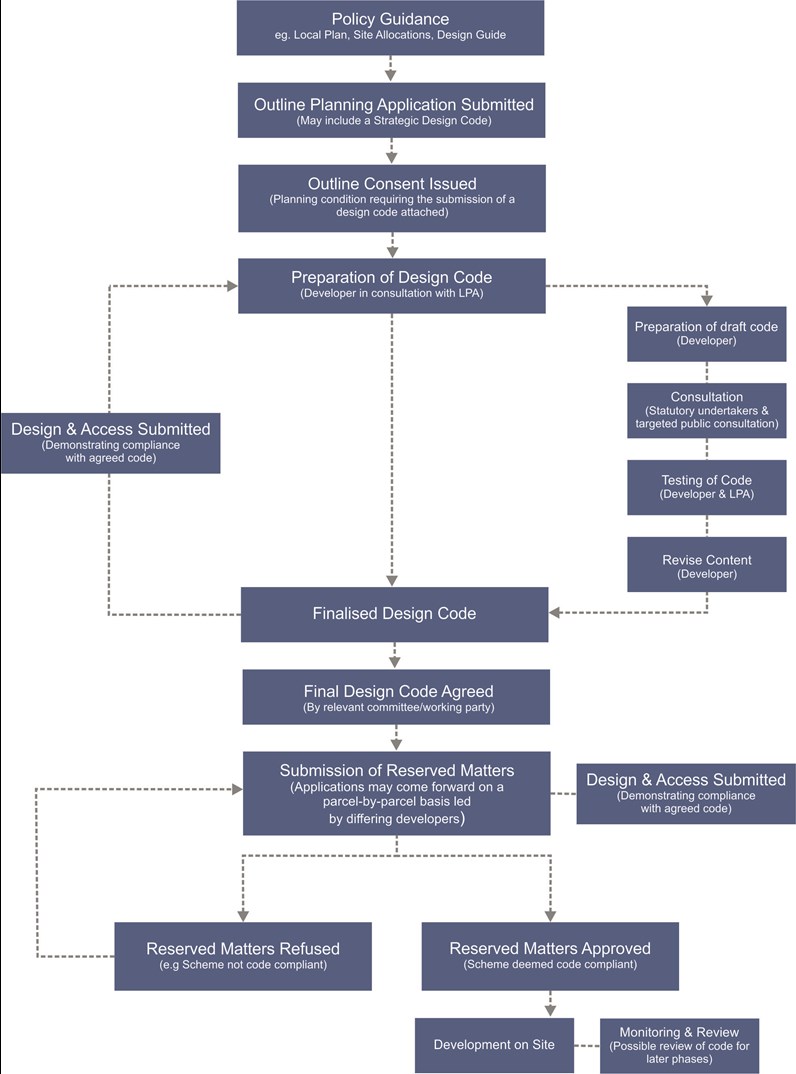When planning and designing any new settlement or neighbourhood the focus must be on creating a new place that will be fit for purpose and mature successfully. This will likely entail looking at the characteristics of the site, its context, distribution and intensity of uses, the shape and richness of the movement network and the attributes (both positive and negative) of the site and surrounding area. These matters at a larger scale are usually managed through statutory plans, design codes, master plans and infrastructure strategies. At a smaller scale, these matters should be set out within a vision document, development brief or a comprehensive design and access statement. The NPPF actively promotes the use of design guides and design codes.
'To provide maximum clarity about design expectations at an early stage, plans or supplementary planning documents should use visual tools such as design guides and codes. These provide a framework for creating distinctive places, with a consistent and high quality standard of design. However their level of detail and degree of prescription should be tailored to the circumstances in each place, and should allow a suitable degree of variety where this would be justified.' (NPPF Para 126)
‘A decision-maker should refuse permission for a proposal which “fails to take the opportunities available for improving the character and quality of an area and the way it functions”. (NPPF Para 130)
The NPPF emphasises the significance of design being a matter which involves the local community. Engagement between the developer and other stakeholders (e.g. local planning authority, the community and local Councillors) is important. Engagement can be a means of reconciling local and commercial interests but also clarifying expectations. This section seeks to clarify what tools will be expected to accompany residential proposals in relation to the scale and complexity of the development and characteristics of the site.
“Applications that can demonstrate early, proactive and effective engagement with the community should be looked on more favourably than those that cannot.” (NPPF 128)
Design According to Scale
As well as considering scale as a simple question of numbers or density, it is also important to consider scale in terms of designing from macro to micro. Often the macros scale of development is agreed, yet the meso or micro scale is overlooked at the early stages and when it comes to residential development the devil can be in the detail.
- LARGE SCALE - at a larger scale, focus should be on the creation and integration of identity. Development will always need to meet key political and local objectives, improving the economy, integrating social space, environmental goals and successful reaction to built and natural environment context. It is vital to consider what the broad patterns of use should be and how these uses layer with the movement network. What principle of public and private space will be appropriate and how the development can become locally distinctive but also efficient in its use of resources.
- MEDIUM SCALE - at a medium scale, scheme s usually involve creation of one or two new development parcels or blocks. Integrate new streets and other public spaces. Such scheme will often focus on one land use but where appropriate they should include ancillary uses to serve new residents, such as a local shop, community centre or school. At this scale, focus should not be on an entirely new identity but on successful integration and completing the existing areas character. Success at this scale will rely heavily on contextual analysis. The edges of such schemes are particularly important. Once common approach is to put the back of new buildings against the back of existing ones. Another is to leave open space or a landscapes buffer between old and new development creating an interesting transitions.
- SMALL SCALE - At the smaller scale, planning and design focuses on the impact of change on the immediate neighbours and the wider street-scene. Issues of prevailing characteristics, rhythm, form and design will also be consider alongside outlook and light.
The adjacent funnel shows this progression through the design scales.

Design Funnel
Design Codes
It is vital that development proposals are accompanied with a clear placemaking vision; providing a coordinated approach to development and help to proactively plan for better design. Codes invest resources upfront to streamline later processes on the basis of consensus instead of conflict.
Design Codes are defined in the NPPF Glossary as: A set of illustrated design requirements that provide specific, detailed parameters for the physical development of a site or area. The graphic and written components of the code should build upon a design vision, such as a masterplan or other design and development framework for a site or area.
What are the advantages of codes?
There are a number of positive benefits of design codes for all parties involved, including:
- Greater design quality, character and sense of place.
- Greater co-ordination of different aspects at an earlier stage (e.g. highways, landscape and architecture), which avoid changes later in the process.
- Greater certainty for developers.
- Potentially faster process.
- Better design cohesion between different developments or phases in an area.
What sites would benefit from design codes?
Those application sites which fall into one of the three categories below should consider the use of design codes.
- Medium Scale Development (10-49 units)
- Large Scale Development (50-100 units)
- Urban Extension or Neighbourhood (above 100 units)
In particular, those sites that include any of the following characteristics should submit design codes:
- Large sites (or multiple smaller related sites) that will be built out in phases over a long period of time.
- Sites in multiple ownership, where coordination between the parties is desirable.
- Sites likely to be developed by several different developers and/or design teams.
What Should Codes Include?
Design Codes should be focussed, succinct documents but above all offer clarity in precisely what will be delivered and how it will be delivered.
- An overall regulating plan (usually a strategic Masterplan which also references all relevant codes on one plan)
- Phasing Plan (how each block or sub-area will be delivered in sequence)
- Building types - the range of building types (e.g. semi-detached, commercial blocks, flats, mixed use blocks, town houses).
- Urban form principles (urban structure, massing, landuse, movement and access)
- Density and Building Heights (the location and range of building heights and density)
- Settlement Patterns (key structuring principles that relate to character or grouping's within the development area. This may define distinct character areas, where relevant)
- Townscape (street types, landmarks, vistas and focal points)
- Block principles (handling of blocks and different block types)
- Frontages (principles for building frontages and set back)
- Street and movement hierarchy (details of street design and character, in line with street hierarchy, including junctions between different street types)
- Parking (strategies for parking and how this is accommodated on street or off street)
- Sustainability principles (sustainability and the consideration of climate change should be reflected in the overarching objectives of the design code, informing all aspects of design. As well as site wide issues, this section may set specific benchmarks on for example energy, materials, water conservation, sustainable drainage and waste).
- Landscaping (comprehensive landscaping/green infrastructure plan)
- Key spaces and open spaces (key characteristics of civic and green spaces)
- Public art (Integration of public art into the scheme)
- Focal point/corner/termination buildings (characteristics of key buildings or features)
- Self build (codes should include opportunities for self build plots).
- Materials (including surfacing, public realm, elevational, roofing and how these will be mixed to create variety and interest).
The flowchart below indicates how the primary content of a design code should be delivered in sequence:

The Design Code Process
The flowchart below indicates the expected procedural route for the effective implementation of a design code.

Benchmarking Development Using Building for Life Assessment
Residential development within the District is essential for growth, the economy, housing provision and the creation of new communities. Yet the value of good design is something which cannot always be measured or processed in facts or figures. The Design Council (formally CABE) have created a 'Building for Life Assessment' which provides a baseline for considering quality and design success. Building for Life is the recognised industry standard for the design of new housing developments.
Design Council firmly believes that housing should be attractive, functional and sustainable. The third edition of the Building for Life standard is based on the National Planning Policy Framework (NPPF) and responds to the Government’s commitment to build more homes, better homes and involve local communities in the planning process.
Using what is essentially a process of SWOT analysis; the assessment takes a holistic approach and breaks each development down into principal and sub-questions which combine to generate a placement on a simple traffic light system. A well designed scheme should perform well against all 12 of the recognised categories.
The BFL assessment then brings those findings together to identify patterns and common ground where design deficiencies tend to occur or where the design process is embedding particular threats. NNDC would encourage all new residential developments over ten units to consider undertaking the BFL12 assessment as part of design process and through the testing phase of any emerging design code. More information on the BFL Assessment can be found here: https://www.designcouncil.org.uk/resources/guide/building-life-12-third-edition